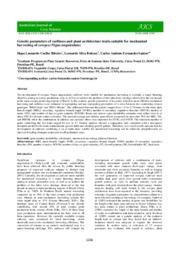Genetic parameters of earliness and plant architecture traits suitable for mechanical harvesting of cowpea (Vigna unguiculata).
Genetic parameters of earliness and plant architecture traits suitable for mechanical harvesting of cowpea (Vigna unguiculata).
Autoria: RIBEIRO, H. L. C.; BOITEUX, L. S.; SANTOS, C. A. F.
Resumo: The development of cowpea (Vigna unguiculata) cultivars more suitable for mechanical harvesting is currently a major breeding objective aiming to reduce production costs as well as to address the problem of the labor force shortage observed in the last decade in the main cowpea-producing regions of Brazil. In this context, genetic parameters of key traits related to more efficient mechanical harvesting and earliness were estimated in segregating and non-segregating generations of a cross between two contrasting cowpea genotypes ?BRS Carijó? and ?BR14 Mulato?. The differences between the parents ranged from 1.13 to 2.70 times for the traits main branch length (MBL); secondary vegetative branch length (SVBL); number of secondary vegetative branches (NSVB); number of nodes (NN), and number of days to grain maturity (NDGM). Broad and narrow sense heritability estimates were either close to or above 50% for all traits under evaluation. The parental average and additive gene effects accounted for more than 78% for MBL, NN, and NDGM, while the combination of additive and epistatic effects was important for SVBL and NSVB. The minimum number of genes controlling the five traits ranged for two to 17. Genetic analysis showed a segregation ratio consistent with a monogenic dominant model for the traits indeterminate growth habit and climbing growth pattern. Therefore, our overall results indicate that the development of cultivars combining a set of traits more suitable for mechanical harvesting can be relatively straightforward via classical breeding strategies employed in self-pollinated crops
Ano de publicação: 2014
Tipo de publicação: Artigo de periódico
Unidade: Embrapa Semiárido
Observações
1 - Por padrão são exibidas publicações dos últimos 20 anos. Para encontrar publicações mais antigas, configure o filtro ano de publicação, colocando o ano a partir do qual você deseja encontrar publicações. O filtro está na coluna da esquerda na busca acima.
2 - Para ler algumas publicações da Embrapa (apenas as que estão em formato ePub), é necessário ter, no celular ou computador, um desses softwares gratuitos. Sistemas Android: Google Play Livros; IOS: iBooks; Windows e Linux: software Calibre.
Acesse outras publicações
Acesse a Base de Dados da Pesquisa Agropecuária (BDPA) para consultar o acervo completo das bibliotecas da Embrapa.

